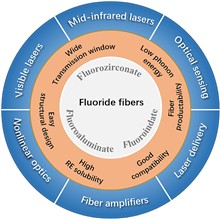 View fulltext
View fulltext
Nanophotonic devices achieve ultrasensitive detection of chiral molecules, enabling precise identification of their stereochemical properties and molecular handedness with unprecedented accuracy. This breakthrough technology transforms pharmaceutical research, drug development, and chemical analysis across multiple scientific disciplines.
The mid-infrared (mid-IR) spectral region (2–25 µm) holds immense promise for applications in molecular spectroscopy, environmental sensing, biomedical diagnostics, and defense technologies. Among various enabling platforms, fluoride glass fibers stand out due to their broad transmission window, low phonon energy, and excellent rare-earth ion solubility, making them ideal candidates for high-efficiency mid-IR photonic systems. This review comprehensively examines the materials science, fabrication strategies, and laser applications of mid-IR fluoride fibers. We critically examine the structural and optical properties of leading glass systems—fluozirconate, fluoroaluminate, and fluoroindate—highlighting their roles in fiber design and mid-IR luminescence. State-of-the-art fabrication methods, including built-in casting, rod-in-tube, extrusion, and crucible-based fiber drawing, are analyzed in detail alongside the latest commercial fiber developments. Particular emphasis is placed on rare-earth-doped fluoride fiber lasers and supercontinuum sources, covering their physical mechanisms, system architectures, and emerging application scenarios. Finally, the current challenges in glass stability, fabrication scalability, and moisture resistance are discussed, and future research directions are proposed to advance fluoride fibers toward practical mid-IR photonic integration. This review aims to provide insights into the multidisciplinary progress driving the next generation of mid-IR fiber technologies.
Nanophotonic chiral sensing enables the characterization of the optical activity of chiral molecules, even at ultralow concentrations, whereas conventional chiroptical spectroscopy is limited to bulk measurements requiring high concentrations. This review provides a comprehensive overview of nanophotonic chiral sensing, covering fundamental principles to practical experimental considerations. We first introduce the theoretical framework of chiral light-matter interactions, including the electromagnetic description of chiral molecules and the chiral structures of light. Discussion on the chiral structure of light encompasses spin angular momentum, optical helicity, optical chirality, and zilches. We then review various chiral sensing mechanisms, such as single-molecule circular dichroism enhancement, nanophotonically induced circular dichroism in sensor-molecule complexes, chiral spectral shifts, molecule-nanostructure Coulomb interactions, and the chiral Purcell effect, along with their experimental implementations. We also present guidance on chiroptical spectroscopy instrumentation, covering both conventional and emerging techniques. Finally, we provide our perspectives on future research directions in nanophotonic chiral sensing. We hope that this review will inspire further advancements in precise chiral sensing beyond current detection limits.
Non-Hermitian physics, which studies systems with nonconservative interactions with the environment, has attracted growing interest. Unique phenomena such as enhanced sensing, the non-Hermitian skin effect, and novel topological behaviors have been extensively explored. Photonic systems serve as ideal platforms to investigate these effects because of inherent decoherence and loss of photons. Non-Hermitian photonics not only reveals intriguing physical effects but also offers new avenues for manipulating light and its associated information, enabling device-level applications. This review summarizes recent progress in non-Hermitian photonic systems. We begin by introducing key concepts and theorems, including the connection between master equations and non-Hermitian Hamiltonians, pseudo-Hermiticity, parity-time symmetry, conserved quantities, exceptional points, and biorthogonal theory. Based on this foundation, we discuss how various platforms—including bulk optics, waveguides, optical cavities, fibers, synthetic dimensions, and metamaterials—simulate non-Hermitian systems. Particular focus is given to the construction of effective non-Hermitian Hamiltonians and operators. We introduce the non-Bloch band theory through a photonic quantum walk platform, highlighting the roles of non-Hermitian topology under complex spectra, which may stimulate advances in both fundamental research and practical applications. Finally, we review unique phenomena and potential applications in sensing, chiral state transfer, quantum algorithms, and other emerging non-Hermitian photonic devices.













